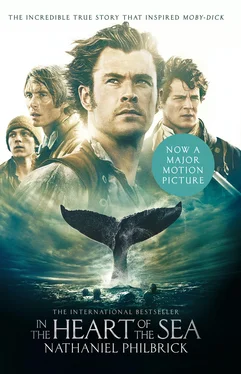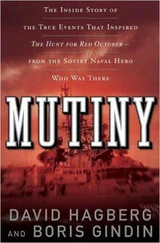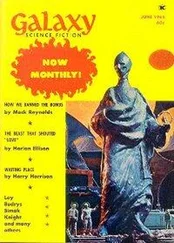Now that the hull was no longer acting as a shield, the officers quickly realized that the squall had passed. But even if the wind had diminished, it was still blowing hard. The ship’s bow was now pointed into the wind, the sails blown back against the masts. The rigging creaked in an eerie, unfamiliar way as the hull wallowed in the rainwhipped waves. The deck shifted, and the green hands temporarily lost their balance. This time the ship wasn’t going over, she was going backward, water boiling up over the quarterdeck as her broad transom was pushed back against the waves, pummeling the spare whaleboat stored off the stern.
Going backward in a square-rigged ship was dangerous. The sails were plastered against the masts, making it almost impossible to furl them. The pressure placed an immense amount of strain on the stays and spars. Since the rigging had not been designed for loads coming from this direction, all three masts might come tumbling down, domino fashion, across the deck. Already the windows in the stern were threatening to burst open and flood the captain’s cabin. There was also the danger of breaking the ship’s tall, narrow rudder, which became useless as water pressed against it.
Eventually, the Essex ’s bow fell off to leeward, her sails filled, and she was once again making forward progress. Now the crew could do what they should have done before the storm—shorten sail.
As the men aloft wrestled with the canvas, the wind shifted into the northwest and the skies began to brighten. But the mood aboard the Essex sank into one of gloom. The ship had been severely damaged. Several sails, including both the main topgallant and the studding sail, had been torn into useless tatters. The cookhouse had been destroyed. The two whaleboats that had been hung off the port side of the ship had been torn from their davits and washed away, along with all their gear. The spare boat on the stern had been crushed by the waves. That left only two workable boats, and a whaleship required a minimum of three, plus two spares. Although the Essex ’s stern boat could be repaired, they would be without a single spare boat. Captain Pollard stared at the splintered mess and declared that they would be returning to Nantucket for repairs.
His first mate, however, disagreed. Chase urged that they continue on, despite the damage. The chances were good, he insisted, that they would be able to obtain spare whaleboats in the Azores, where they would soon be stopping to procure fresh provisions. Joy sided with his fellow mate. The captain’s will was normally the law of the ship. But instead of ignoring his two younger mates, Pollard paused to consider their arguments. Four days into his first command, Captain Pollard reversed himself. “After some little reflection and a consultation with his officers,” Nickerson remembered, “it was deemed prudent to continue on our course and trust to fortune and a kind providence to make up our loss.”
The excuse given to the crew was that with the wind now out of the northwest, it would have taken too long to return to Nantucket. Nickerson suspected that Chase and Joy had other motives. Both knew that the men had not taken kindly to their treatment by the mates. Seeing the knockdown as a bad omen, many of the sailors had become sullen and sour. If they returned to Nantucket, some of the crew would jump ship. Despite the seriousness of the loss of the whaleboats, it was not the time to return to port.
Not surprisingly, given that he was the object of much of the crew’s discontent, Chase, in his own account of the accident, never mentions that Pollard originally proposed turning back. As Chase would have it, the knockdown was only a minor inconvenience: “We repaired our damage with little difficulty, and continued on our course.” But Nickerson knew differently. Many of the Essex ’s men were profoundly shaken by the knockdown and wanted to get off the ship. Whenever they passed a homeward-bound vessel, the green hands would lament, in the words of one, “O, how I wish I was onboard with them going home again, for I am heartily sick of these whaling voyages”—even though they had not yet even seen a whale.
CHAPTER THREE
First Blood
AFTER A PROVISIONING STOP in the Azores, which provided plenty of fresh vegetables but no spare whaleboats, the Essex headed south toward the Cape Verde Islands. Two weeks later they sighted Boavista Island. In contrast to the Azores’ green, abundant hills, the slopes of the Cape Verdes were brown and sere, with no trees to offer relief from the burning subtropical sun. Pollard intended to obtain some hogs at the island of Maio a few miles to the southwest.
The next morning, as they approached the island, Nickerson noticed that Pollard and his mates were strangely animated, speaking to each other with a conspiratorial excitement as they passed a spyglass back and forth, taking turns studying something on the beach. What Nickerson termed “the cause of their glee” remained a mystery to the rest of the crew until they came close enough to the island to see that a whaleship had been run up onto the beach. Here, perhaps, was a source of some additional whaleboats—something the men of the Essex needed much more desperately than pork.
Before Pollard could dispatch one of his own boats to the wreck, a whaleboat was launched from the beach and made its way directly toward the Essex. Aboard the boat was the acting American consul, Ferdinand Gardner. He explained that the wrecked whaler was the Archimedes of New York. While approaching the harbor she had struck a submerged rock, forcing the captain to run her up onto the beach before she was a total loss. Gardner had purchased the wreck, but he had only a single whaleboat left to sell.
While one was better than nothing, the Essex would still be dangerously low on boats. With this latest addition (and an old and leaky addition at that), the Essex would now have a total of four whaleboats. That would leave her with only one spare. In a business as dangerous as whaling, boats were so frequently damaged in their encounters with whales that many whaleships were equipped with as many as three spare boats. With a total of only four boats, the crew of the Essex would have scant margin for error. That was disturbing. Even the green hands knew that one day their lives could depend on the condition of these fragile cockleshells.
Pollard purchased the whaleboat, then sailed the Essex into the cove that served as Maio’s harbor, where pointed hills of bone-white salt—procured from salt ponds in the interior of the island—added a sense of desolation to the scene. The Essex anchored beside another Nantucket whaleship, the Atlantic , which was off-loading more than three hundred barrels of oil for shipment back to the island. Whereas Captain Barzillai Coffin and his crew could boast of the seven or so whales they’d killed since leaving Nantucket on the Fourth of July, the men of the Essex were still putting their ship back together after the knockdown in the Gulf Stream and had yet to sight a whale.
White beans were the medium of exchange on Maio, and with a cask of beans aboard, Pollard took a whaleboat in to procure some hogs. Nickerson was at the aft oar. The harbor was without any docks or piers, and in the high surf, bringing a whaleboat into shore was exceedingly tricky. Even though they approached the beach at the best possible part of the harbor, Pollard and his men ran into trouble. “Our boat was instantly capsized and overset in the surf,” Nickerson recalled, “and thrown upon the beach bottom upwards. The lads did not much mind this for none were hurt, but they were greatly amused to see the captain get so fine a ducking.”
Читать дальше












